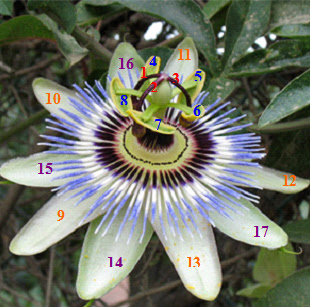In my last post I misplaced the Passion in the passionflower. I also mentioned that the botanists gave the Passion flower its name. I stand corrected. According to Muriel Fisch (1975) the name was given by Spanish Catholic missionaries who saw in the flower the symbolism of the “Passion of the Christ”. Passus means suffering , Flos means flower.


This is how the symbolism goes:
1, 2 and 3 are the knobbed stigmas that represent the three nails/Christ and the two thieves.
4, 5, 6, 7 and 8 are stamens that represent the five wounds or the hammers used to drive the nails.
9, 10, 11, 12, 13 are the petals and 5 sepals (14, 15, 16, 17, one sepal missing here) represent the 10 apostles (with Peter who denied the Lord and Judas who betrayed him, missing).
Corona(or the frill) represent the crown of thorns/ halo. (The 72 filaments in the corolla represent the number of thorns that in the crown).
The three bracts (not seen in the photo) symbolize the trinity.The lobed leaves symbolized the hands of accusers. Some also think of the trilobed leaves to represent the spear that pierced Christ’s side.
The reed-like stem of passionflower vine is associated with the passage “Christ was given Vinegar on reed.
1, 2 and 3 are the knobbed stigmas that represent the three nails/Christ and the two thieves.
4, 5, 6, 7 and 8 are stamens that represent the five wounds or the hammers used to drive the nails.
9, 10, 11, 12, 13 are the petals and 5 sepals (14, 15, 16, 17, one sepal missing here) represent the 10 apostles (with Peter who denied the Lord and Judas who betrayed him, missing).
Corona(or the frill) represent the crown of thorns/ halo. (The 72 filaments in the corolla represent the number of thorns that in the crown).
The three bracts (not seen in the photo) symbolize the trinity.The lobed leaves symbolized the hands of accusers. Some also think of the trilobed leaves to represent the spear that pierced Christ’s side.
The reed-like stem of passionflower vine is associated with the passage “Christ was given Vinegar on reed.
The axillary coiling tendrils represent the cords or whips used by the persecutors. The 30 round marks found on the lower side of some leaves are representative of the 30 pieces of silver which tempted Judas to betray Christ. The white in the flower represents the emblem of purity — the blue, the heaven. The three days the flower remains wide open before it fades away, denote the death, burial and resurrection of Christ. So there is a lot in the name of THIS flower. The religious zeal and the fertile human mind does work wonders!
Coming to the taxonomic and economic aspects of the plant, Passiflora belongs to the family Passifloraceae. This family belongs to the order Violales and contains about 20 genera and 600 species. The plants in this family range from herbaceous or woody vines to shrubs and trees.The plants grow in tropical climate. There are more than 400 known species of the genus Passiflora of which 50-60 bear edible, fragrant fruits. The centre of diversity for this plant is Brazil South America . In Europe, the U.S and Canada
With such diverse medicinal uses the plant definitely holds an important place. Its not just a pretty flower, it is a flower with a punch!
With such diverse medicinal uses the plant definitely holds an important place. Its not just a pretty flower, it is a flower with a punch!